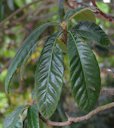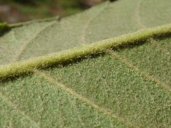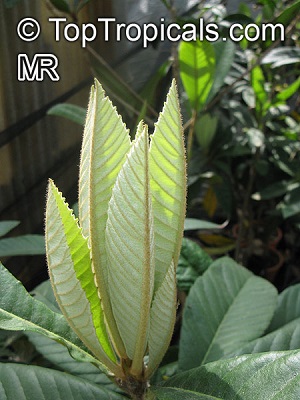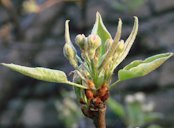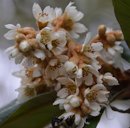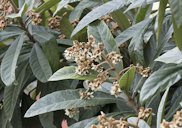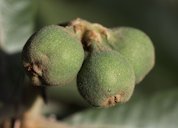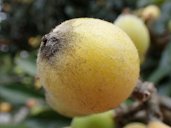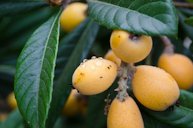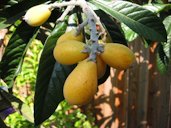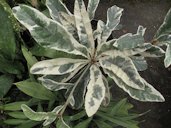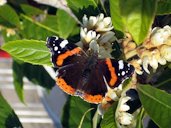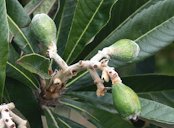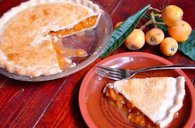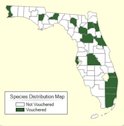| Loquat, Japanese plum - Eriobotrya japonica | |||||||||||||||||||||||||||||||||||||||||||
|---|---|---|---|---|---|---|---|---|---|---|---|---|---|---|---|---|---|---|---|---|---|---|---|---|---|---|---|---|---|---|---|---|---|---|---|---|---|---|---|---|---|---|---|
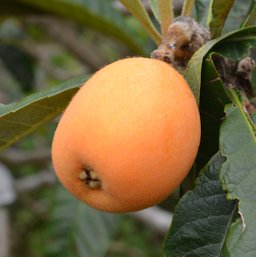 Fig. 1  Eriobotrya japonica Japanese Loquat, Minamiboso city, Japan 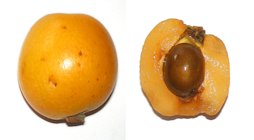 Fig. 2   Fig. 3  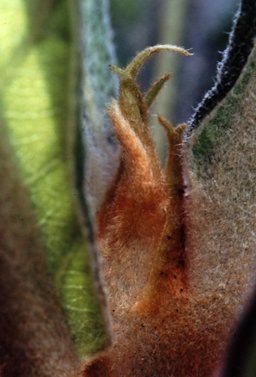 Fig. 4  Débourage d'un bourgeon de bibacier ou néflier du Japon (E. Japonica) 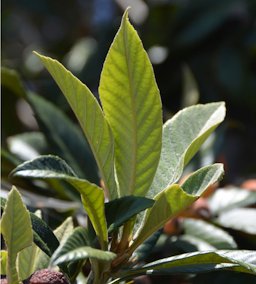 Fig. 5   Fig. 6  Loquat (E. japonica) leaves in a park in London, England  Fig. 11  Inflorescense  Fig. 12  E japonica, Loquat, Napier, South Africa 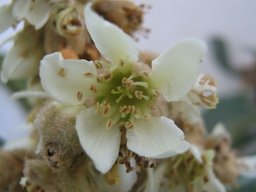 Fig. 13  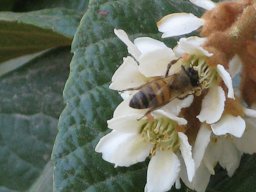 Fig. 14  Hymenoptera on blooming E. japonica in Jerusalem 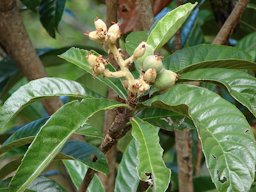 Fig. 18  E. japonica (Loquat, pipa, Japanese plum), fruit at Olinda, Maui, Hawai'i 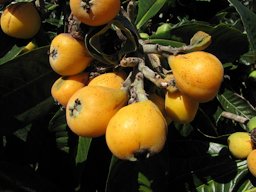 Fig. 19  E. japonica (Loquat, pipa, Japanese plum) fruit at Shibuya Farm Kula, Maui, Hawai'i 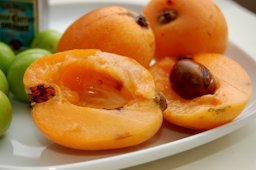 Fig. 20  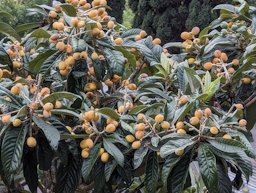 Fig. 21  Loquat E. japonica, Machico, Portugal 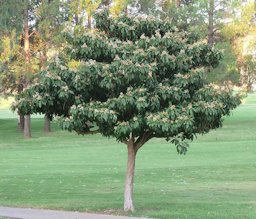 Fig. 31  Loquat tree at the Wingate Park country club in Pretoria, South Africa 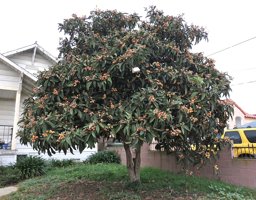 Fig. 32  Loquat (E. japonica) tree with fruit 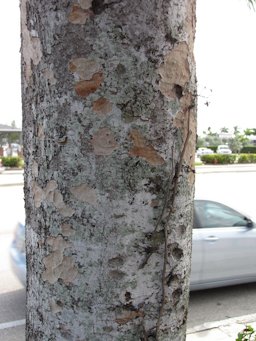 Fig. 34  Trunk and bark, Starbucks Boynton Beach, Florida 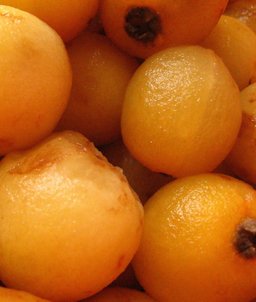 Fig. 35  The fruit once peeled, there are 2-4 large seed pods in the center, and the flesh is quite grainy 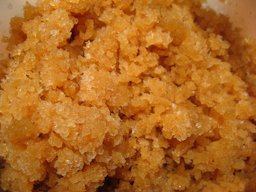 Fig. 36  Loquat sorbet, the perfect Christmas-in-Summer dessert!  Fig. 40  Chamaeleo, chamaeleon sitting on a blossoming E. japonica  Fig. 41  Loquat in the market of the casbah of Algiers Fig. 42   Fig. 43  My own 'Champagne' loquats 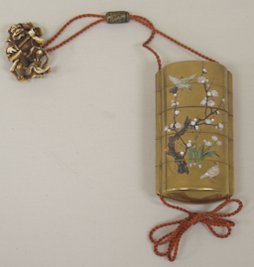 Fig. 44  Inrō with birds, plum, chrysanthemum, and loquat (Japanese case for holding small objects) |
Scientific
name Eriobotrya japonica (Thunb.) Lindl. Pronunciation air-ee-oh-BOT-ree-uh juh-PAWN-ih-kuh 8 Common names English: Japanese-medlar, loquat; Afrikaans: lukwart; French: bibassier, néflier du Japon; German: japanische Mispel, japanische Wollmispel; Portuguese: nespereira; Spanish: níspero, níspero del Japón, nispolero; Portuguese: ameixa do Japao; Chinese: luju; Maylay and Indonesian: lokwat 2,7 Synonyms Crataegus bibas, Mespilus japonicus, Photinia japonica 2 Relatives Apple, Malus domestica; blackberry, Rubus spp: capulin, P. salicifolia; chickssaw plum, P. augustifolia; mayhaw, Crataegus spp.; peach, P. persica; pear, Pyrus spp. and strawberry, Fragaria ananassa 3 Family Rosaceae (rose family) Origin Native to cooler hills of south-central China USDA hardiness zones 8a-11 1 Uses Fruit; leaves for herbal tea; landscape specimen; espalier; container or planter 1 Height 20-30 ft (6-9 m) Spread 30-35 ft (9-10.6 m) Crown Round; symmetrical; dense; coarse texture 1 Plant habit Neat habit and compact growth Growth rate Moderate Longevity Orchards over 90 years old still productive Trunk/bark/branches Branches droop; not showy; typically one low-branched trunk; bark grey and shallowly fissured 1,11 Pruning requirement Required for strong structure Leaves Evergreen; alternate; simple; dark green; tough, leathery; pectinate, serrated margin; oblong, elliptic (oval); pinnate; densely velvety-hairy below 1 Flowers White/cream/gray; showy; very fragrant; Oct. to Feb.; summer blooms produce no fruit Fruit Drupe: round, oval; 1-3 in. (2.5-7.6 cm); fleshy; yellow, orange; attacts birds; showy; fruit/leaves a litter problem 1 Season Feb. to May depending on cultivar USDA Nutrient Content pdf Light requirement Full sun, partial sun or partial shade 1 Soil tolerances Clay; sand; loam; alkaline; acidic; well-drained 1 pH preference 5.0–8.0 with 6.0 being optimum 9 Drought tolerance Moderate; not tolerant of flooded soil conditions Aerosol salt tolerance Moderate; it performs well along the coast with some protection from salty air 1 Cold tolerance Very cold tolerant; may withstand 8 to 10 °F (-12 to -13 °C); flowers/fruit are killed below 27 °F (-2.8 °C) 2 Plant spacing 25-30 ft (7.6-9 m) away from structures, electrical lines, and other trees for best production 2 Roots Not a problem; shallow root system Invasive potential * Caution - Central, South: manage to prevent escape. May be recommended by IFAS. Will be reassessed in two years. Pest resistance Sensitive to pests/diseases Known hazard Seeds are said to contain toxins and the leaves traces of arsenic 3 Reading Material Growing Loquat in the Florida Home Landscape, University of Florida pdf Loquat, Fruits of Warm Climates Eriobotrya japonica, Agroforestree Database Loquat, Progress in New Crops, Purdue University Eriobotrya japonica, PROSEA Foundation Origin Records of loquat in China span over 2000 years. The loquat cultivated in Japan was introduced from China in ancient times and loquat cultivation in Japan was described as early as 1180. 9 People beyond eastern Asia first learned of the loquat from Kaempfer, who observed it in Japan and described it in Amoenites Exotica in 1712. In 1784, the loquat was introduced from Guangdong into the National Garden at Paris, and in 1787 was introduced into the Royal Botanical Gardens at Kew, London. From this beginning, loquat was distributed around the Mediterranean to various countries, including Algeria, Cyprus, Egypt, Greece, Israel, Italy, Spain, Tunisia and Turkey. Sometime between 1867 and 1870, loquat was introduced to Florida from Europe and to California from Japan. 9 Description A tree of moderate size, the loquat may reach 20 to 30 ft (6-9 m), has a rounded crown, short trunk, and woolly new twigs. 5 Leaves Leaves mostly in terminal whorls (Fig. 8) are elliptical-lanceolate to obovate-lanceolate, 8-12 in. (20-30.4 cm) long and 1-4 in. (3-10 cm) wide. They are dark green and glossy on the upper surface, whitish to rusty-tomentose on the lower surface. 1,2 The large dried leaves are suitable for mulch.
Fig. 7. E. japonica (Loquat, pipa, Japanese plum), leaf showing veins at Olinda Rd, Maui, Hawai'i Fig. 9. Leaves furry backside, Hawea Pl Olinda, Maui, Hawai'i Fig. 10. New growth Flowers Flowers are borne on 4-8 in. (10-20 cm) long terminal panicles of 30 to 100 or more flowers. Individual flowers are 0.5-0.8 in. (1.25-2 cm) in diameter, have 5 white petals, about 20 stamens, and an inferior ovary. The stems and sepals are covered with rusty, brownish hairs. The environmental factor or factors responsible for flower induction are not known, although a cessation of growth prior to the fall/winter flowering is essential. 2 Flowering in loquat may extend over 1.5–2.5 months, and fruit normally ripen about 150–200 days from flowering. 9
Fig. 17. Flowers of loquat (E. japonica), Seyhan, Adana, Turkey Fruit Fruit are pomes, held in clusters of 4 to 30, oval to rounded to pear-shaped, 2 to 5 cm long and weigh an average of 30 to 40 g; some cultivars up to 70 g. The peel is smooth to slightly downy, light yellow to orange. The pulp is white to light yellow to orange, 6.7 to 17° Brix, sweet to sub acid, and juicy. There may be 1 to 10 dark brown seeds. 2 The loquat is a non-climacteric fruit and shows no climacteric rise in respiration and no peak of ethylene production either on the tree or after harvest. The fruit does not abscise after ripening but shrinks on the tree. 9
Fig. 23. Loquat fruit (E. japonica) in the Jardim Botânico Tropical in Lisbon Fig. 26. E. japonica, when the fruit has ripened, Irvine, California Fig. 27. E. japonica (Thunb.) Lindl., dried loquat seeds Fig. 28. Protective packaging for loquats, Suzhou, China Varieties Many loquat cultivars exist. Based on origin, two groups are distinguished: the Chinese group with large, pyriform, deep orange fruit, ripening mid-season to late, which can be kept for a week or two, and the Japanese group with small, slender, light-coloured fruit, maturing early and having a shorter shelf life. 12 Although Loquat can easily be grown from seed, many cultivars are available for consistent fruit quality. 'Champagne' (March-May), best for USDA hardiness zone 9, has yellow-skinned, white-fleshed, juicy, tart fruit, one of the better fruits. `Gold Nugget' (May-June), best near coast, has larger, sweeter fruit with orange skin and flesh. `MacBeth' (April-May) has exceptionally large fruit with yellow skin and creamy flesh. `Thales' is a late yellow-fleshed variety. 'Coppertone', a hybrid, has dense growth with copper-colored new foliage and pale pink flowers. 'Variegata' has white variegated leaves. 1
Fig. 29. Variegated E. japonica (loquat) Eriobotrya japonica 'Variegata': 'Variegata' Loquat, University of Florida pdf Eriobotrya japonica 'Coppertone': 'Coppertone' Loquat, University of Florida pdf Varieties Page Choosing the Right Loquat Variety, Just Fruits and Exotics Harvesting Since loquat fruit are easily injured, fruit should be handled carefully. The fruit are difficult to harvest because of the thick, tough stalk on each fruit that does not separate readily from the cluster, and the fruit must be picked with stalk attached to avoid tearing the skin. Harvesting is by hand. Cut clusters of fruit from terminal branches and then clip individual fruit from the cluster. Ripe loquat fruit may be stored in plastic bags in the refrigerator for several weeks. 2 Loquat is a fruit tree that blooms in the fall and early winter and is harvested during the spring. Mature loquat trees may yield from 35 to 300 lbs per year depending upon tree size and care. 2 Fruit generally will keep for 10 days at ordinary temperatures, and for 28–60 days in cool storage. 9 Pollination Loquat trees are pollinated by various insects including bees (Apis sp.), syrphids, houseflies, Myrmeleontidae, Bombinae, and Pieris rapae (L.). Although they are considered self-compatible, cross pollination improves fruit set and size. 1
Fig. 30. Vanessa atalanta na mušmuli u Dramlju, Hrvatska, Croatia Propagation Loquat trees may be propagated by seed, but they do not come true from seed and they have a 6-to 8 -year juvenile period before flowering and fruiting. 2 Loquat may be cleft, veneer, and whip grafted or chip, patch, or shield budded. Propagation by cuttings and marcottage is also possible but more difficult. Vegetatively propagated trees generally begin bearing 1 to 2 years after planting. Mature planted trees may be stumped and top-worked to desirable cultivars. Loquat trees may be propagated by tissue culture (somatic embryos), microcuttings, and by micropropagation using terminal or axillary shoots; however, these methods are not common in the U.S. 2 Planting Providing best fruit and form when grown in full sun, Loquat can tolerate partial shade and a variety of well-drained soils. It grows well on soils with a high pH and maintains the characteristic dark green foliage. Clay soil is acceptable as long as there is sufficient slope to allow surface water to run away from the root system. It often looks best in the southern portion of its range when given some shade in the afternoon, especially if it is not irrigated. 1 Culture Originally from regions with a subtropical climate, E. japonica requires a mild climate with rainfall evenly spread throughout the year, without excessive heat, especially during fruit ripening. 11 Winter temperature should be higher than summer temperature not over 95 °F (35 °C). The flowers and fruit of loquat are particularly susceptible to extremes of temperature. Ovules in early fruit are killed by brief exposure to 39 °F (4 °C). 9 Pruning Branches will have to be pruned to grow up, as they tend to droop with time under the weight of the developing branch. It espaliers well against a sunny wall, and makes a good screen due to its dense canopy. Sprouts along the trunk can be a maintenance nuisance. 1 During the first 1 to 2 years after planting, prune young trees by tipping shoots in excess of 2 to 3 ft, tipping will increase branching. Trees may be trained to a modified cental leader or open center configuration. Mature trees may be selectively pruned to maintain trees at 6 to 12 ft in height. This will make care of the tree and harvest easier. 2 Pruning is carried out in autumn or winter when flower buds become visible. Overgrown branches of the tree crown are removed and sprouts are removed or cut back. Pruning is indispensable to reduce the number of bearing shoots and to secure sufficient flower buds. 9 Renovation pruning improves yields and is best carried out in summer, 1 week after harvest. 9 Fruit/Flower Thinning To improve fruit size, you may wish to hand-thin flowers or fruit. Allow anywhere from 4 to 10 fruits to develop per terminal. Thinning will increase fruit size from 25% - 100%. In areas with insects and or bird fruit pests, bag the fruit clusters. Bagging also hastens fruit development and reduces fruit scaring. 2
Fertilizing Caution: Do not overfertilize since this could increase sensitivity to fire blight disease. 1 A month after planting, spread 1/4 lb (113 g) per tree of a young-tree fertilizer, such as 6-6-6 (6 % nitrogen 6% phosphate 6% potassium) with minor elements. Twenty to 30% of the nitrogen should come from organic sources. Repeat this every 8 weeks for the first year. Then, gradually increase the amount of fertilizer to 0.5, 0.75, 1.0 lb etc., (227 g, 341 g, 454 g, etc.) as the trees grow. Four to 6 dry fertilizer applications per year may be made up to the third year. 2 A foliar fertilizer mix composed of magnesium and minor nutrients (manganese, zinc, boron, and molybdenum) may be applied 2 to 3 times per tree per year any time from April to November. 2 For mature trees, fertilize trees 2 to 3 times per year. The fertilizer should be applied just before or at bloom, perhaps during late fall, again in March, and once during the summer. The fertilizer mix should also include phosphate (P2O5) and potash (K2O). 2 Because loquat is sensitive to salt, organic, rather than chemical, fertilizer should be used. Any fertilizer should have no more than 6% nitrogen if the tree is to flower. 10 Irrigation Newly planted loquat trees should be watered at planting and every other day for the first week or so and then 1 to 2 times a week for the first couple of months. For the first 3 years,water once a week during prolonged dry periods (e.g., 5 or more days of little to no rainfall). Once the rainy season arrives, reduce or stopped watering. 2 Once loquat trees are 4 or more years old, water them during the fruit development period and during prolonged dry periods. Over watering may cause trees to decline or be unthrifty. 2 Pests Page Scales and caterpillars are occasional problems. Diseases Page To reduce fireblight problems, provide good air circulation and keep away from other fireblight hosts, such as Pyracantha, pears, etc. If leaves and stems blacken from the top downward, prune back one-foot or more into healthy wood. Sterilize shears with a mixture of one part bleach to nine parts water between cuts. 1 Food Uses Loquat may be eaten fresh without the peel, combined with other fruits in fruit salads, used as a pie filling, and made into sauces and gelatin desserts, jams, and jellies. Fruit may also be canned, dried, frozen, and made into syrup. 2 Blanched Loquats: to peel loquats for sauce and fruit cup, blanch by pouring boiling water over loquats to cover. Add 1/4 cup lemon juice to each quart of water. Cook over low heat about 5 minutes, just until skin loosen. Drain and reserve liquid. Cool, peel, halve, and seed loquats (remove seeds). 8
Fig. 38. Banana loquat custard pizzelle Fig. 39. Loquat oatmeal and white chocolate chip muffins Other recipes: Loquat sorbet: (Fig. 34) 3 cups puréed fruit + one-half to one cup sugar (to taste) + juice of half a lemon + a pinch of cinnamon, a little ground cloves, some ginger and nutmeg; mix well, put in a tupperware in the freezer, shake-shake-shake every hour or so to break up the crystals Florida Food Fare: Loquats, University of Florida pdf (archived) Loquat: Getting a Grip on Grappa, Eat The Weeds Loquat, Twelve Fruits Project, University of Hawai'i at Mānoa Alcoholic Beverage Loquats can also be used to make light wine. It is fermented into a fruit wine, sometimes using just the crystal sugar and white liquor. In Italy nespolino liqueur is made from the seeds, reminiscent of nocino and amaretto, both prepared from nuts and apricot kernels. Both the loquat seeds and the apricot kernels contain cyanogenic glycosides, but the drinks are prepared from varieties that contain only small quantities (such as Mogi and Tanaka), so there is no risk of cyanide poisoning. 6 Medicinal Uses ** For thousands of years, the Chinese used extract from loquat leaves as an important ingredient for lung ailments. 4 The fruit is said to act as a sedative and is eaten to halt vomiting and thirst. The flowers are regarded as having expectorant properties. An infusion of the leaves, or the dried, powdered leaves, may be taken to relieve diarrhea and depression and to counteract intoxication from consumption of alcoholic beverages. Leaf poultices are applied on swellings. 5 Other Uses In Japan, the leaves are commonly used to make a tea. There, the leaves are picked green, washed and their bottoms scraped to remove fine hairs, then dried and cut for brewing. 10 Loquat is a good source of vitamin A; just a few fruits can provide up to half the recommended daily allowance. Vitamin A is important to visual and dental health. 4 Loquat is highly nectariforous, with a heavy fragrance and has high honey potential. 9 Its blossoms were used to make perfumes in the 1950s. The quality of the perfume was said to be outstanding, but the yield was low and not commercially viable. Some individuals suffer headache when too close to a Loquat tree in bloom, the aroma from the flowers sweet and penetrating. 8 Its neat habit and compact growth make loquat an ideal specimen or patio shade tree, and it can be used as a residential street tree or median strip tree in areas where overhead space is limited. 1 General Loquat is among the first fruits cultivated in Asia and is steeped in ancient Chinese mythology. For centuries only the Chinese royalty was allowed to eat the fruit, as it was thought that loquat fruit falling into the rivers gave the koi, or carp, the strength and desire to swim against current and up waterfalls and be turned into mythical dragons. The fruit was introduced from China to Japan as early as 700 AD. In 914 the first Chinese medical textbook was translated to Japanese and mentioned how to use loquat to obtain clear lungs. Japanese law books in the early 900s stated the proper way to present loquat as an offering to the Shinto gods. In Hawai‘i, loquat is sometimes called pipa (Chinese) or biwa (Japanese). 4 The generic name is derived from the Greek words ‘erion’ (wool) and ‘botrys’ (cluster), from the woolly appearance of the spiked inflorescence; the specific epithet means 'of Japan'. 11 In Spanish the fruits are referred to as nísperos (or, in southern areas of Mexico, mísperos) and are associated with the Day of the Dead in Mexico, when they are commonly placed on altars as offerings to the spirits of the deceased. 6 The Florida Loquat Festival, New Port Richey, Florida ext link
Fig. 45. Loquat distribution map, wild populations Further Reading Loquat, Florida Gulf Coast University Plant Database pdf Eriobotrya japonica: Loquat, University of Florida pdf Loquat, Okeechobee News, University of Florida Loquat, California Rare Fruit Growers Loquat, Manual Of Tropical And Subtropical Fruits Loquat: A Subtropical Relative of the Apple, Pear, and Peach, University of Florida, Charlotte County pdf Loquat Botanical Art List of Growers and Vendors |
||||||||||||||||||||||||||||||||||||||||||
| Bibliography 1 Gilman, Edward F., and Dennis G. Watson. "Eriobotrya japonica: Loquat." Environmental Horticulture, UF/IFAS Extension, ENH394, Publication date Nov. 1993, Revised Feb. 2013 and Dec. 2018, AskIFAS, edis.ifas.ufl.edu/publication/ST235. Accessed 23 Mar. 2017, 3 Apr. 2024. 2 Crane, Jonathan H., and Caldeira M. Lilia. "Loquat Growing in the Florida Home Landscape." Horticultural Sciences Dept., UF/IFAS Extension, HS5, Original pub. Jan. 1980, Revised Oct. 2005 and Nov. 2016, Reviewed Dec. 2019,June 2023, AskIFAS, edis.ifas.ufl.edu/mg050. Accessed 23 Mar. 2017, 3 Aug. 2020, 3 Apr. 2024. 3 Boning, Charles R. Florida's Best Fruiting Plants- Native and Exotic Trees, Shrubs, and Vines. Sarasota, Pineapple Press, 2006. 4 Love, Ken, et al. "Twelve Fruits With Potential Value-Added and Culinary Uses." University of Hawai‘i at Mānoa, College of Tropical Agriculture and Human Resources, 2007. Accessed 17 Mar. 2016. 5 Fruits of Warm Climates. Julia F. Morton, Miami, 1987. 6 "Loquat." Tropical and Subtropical Fruits: Postharvest Physiology, Processing and Packaging, Editor(s): Muhammad Siddiq, UF/IFAS Extension, wikipedia.org. Accessed 21 Mar. 2016. 7 "Eriobotrya japonica (Thunb.) Lindl. common names." npgsweb.ars-grin.gov/gringlobal/taxonomydetail.aspx?id=15602. Accessed 9 Mar. 2018. 8 Deane, Green. "Loquat: Get a Grip on Grappa." Eat the Weeds and other things, too. www.eattheweeds.com. Accessed 20 Mar. 2016. 9 The Encyclopedia of Fruit & Nuts. Edited by Jules Janick and Robert E. Paull, Cambridge, CABI, 2008. 10 "Growing Loquat: Eriobotrya japonica." Garden Oracle, gardenoracle.com/images/eriobotrya-japonica.html. Accessed 31 Mar. 2024. 11 Orwa, C., et al. "Eriobotrya japonica Lindl." Agroforestree Database: a tree reference and selection guide, version 4.0., 2009, Agroforestry, apps.worldagroforestry.org/treedb2/speciesprofile.php?Spid=735. Accessed 1 Apr. 2024. 12 Hiep, N. T., and E. W. M. Verheij. "Eriobotrya japonica (Thunb.) Lindley." Plant Resources of South East Asia No 2. Edible fruits and nuts, Edited by E. W. M. Verheij, and R. E. Coronel, PROSEA Foundation, Bogor, Indonesia, record 1502, 1991, PROSEA, (CC BY-SA 3.0), prosea.prota4u.org/view.aspx?id=1502. Accessed 2 Apr. 2024. Photographs Fig. 1 Katorisi. "Japanese Loquat, Minamiboso city, Japan." Wikimedia Commons, 31 May 2020, (CC BY-SA 4.0), Image cropped, commons.wikimedia.org/wiki/File:Japanese_Loquat,_Minamiboso_city,_Japan.jpg. Accessed 2 Apr. 2024. Fig. 2 Serg!o. "Dos nísperos, Eriobotrya japonica, de mercado: uno entero y otro pelado, partido, con hueso y sin rabo." Wikimedia Commons, 28 Mar. 2008, Public Domain, commons.wikimedia.org/wiki/ File:Nísperos_entero_y_partido.jpg. Accessed 2 Apr. 2024. Fig. 3,5,8,16 Ritter, M. and Reimer, J. "Japanese Loquat, Eriobotrya japonica." SelecTree UDEI, 2012, selectree.calpoly.edu. Accessed 18 Mar. 2015. Fig. 4 Daniel, Jean-Philippe. "Débourage d'un bourgeon de bibacier ou néflier du Japon (Eriobotyra Japonica)." Wikimedia Commons, 15 Apr. 2006, commons.wikimedia.org/wiki/File:NeflierDuJapon.JPG. Accessed 19 Mar. 2015. Fig. 6 Dénes, Emőke. "Loquat (Eriobotrya japonica) leaves in a park in London, England." Wikimedia Commons, 5 July 2011, (CC BY-SA 4.0), commons.wikimedia.org/wiki/File:Eriobotrya_japonica_-_London_3.jpg. Accessed 29 Mar. 2024. Fig. 7 Starr, Forest, and Kim. "Eriobotrya japonica (Loquat, pipa, Japanese plum) Leaf showing veins at Olinda Rd, Maui, Hawai'i." Starr Environmental, 7 Jan. 2023, no. 230107-0804, (CC BY 3.0), www.starrenvironmental.com/images/image/?q=52665862914. Accessed 18 2016. Fig. 9 Starr, Forest and Kim. "Eriobotrya japonica (Loquat, pipa, Japanese plum), Leaves furry backside, Hawea Pl Olinda, Maui, Hawai'i." Starr Environmental, 7 jan. 2023, no. 230107-0807, (CC BY 3.0), www.starrenvironmental.com/images/image/?q=52665862359. Accessed 7 Oct. 2014. Fig. 10 MR. "Loquat, Japanese Plum." Top Tropicals, toptropicals.com. Accessed 18 Mar. 2015. Fig. 11 Carr, Gerald, D. "Eriobotrya japonica." University of Hawai'i, Botany Department, Mānoa Campus Plants. botany.hawaii.edu.Accessed 7 Oct. 2014. Fig. 12 Vilas Marchant, Juanita. "Eriobotrya japonica (Thunb.) Lindl. - Loquat - Napier, South Africa." Wikimedia Commons, 2 Aug. 2018, (CC BY-SA 4.0), (GFDL), commons.wikimedia.org/wiki/File:Eriobotrya_japonica00.jpg. Accessed 31 Mar. 2024. Fig. 13 Amarochan, Mohamed. "Eriobotrya japonica flower." Wikimedia Commons, 11 Dec. 2008, commons.wikimedia.org/wiki/File:Eriobotrya_japonica_flower.jpg. Accessed 19 Mar. 2015. Fig. 14 Haklai, Yair. "Hymenoptera on blooming Eriobotrya japonica in Jerusalem." Wikimedia Commons, 25 Oct. 2013, (CC BY-SA 3.0), commons.wikimedia.org/wiki/File:Hymenoptera_on_blooming_Eriobotrya_japonica.jpg. Accessed 18 Mar. 2016. Fig. 15 Momali. "Eriobotrya japonica." Wikimedia Commons, 27 Oct. 2010, GFDL, (CC BY-SA 3.0), commons.wikimedia.org/wiki/File:Blossom0119.jpg. Accessed 29 Mar. 2024. Fig. 17 Cebeci,Zeynel. "Flowers of loquat (Eriobotrya japonica). Seyhan - Adana, Turkey." Wikimedia Commons, 31 Jan. 2016, (CC BY-SA 4.0), commons.wikimedia.org/wiki/File:Eriobotrya_japonica_-_Loquat_03.jpg. Accessed 31 Mar. 2024. Fig. 18 Starr, Forest, and Kim. "Eriobotrya japonica (fruit). Location: Maui, Olinda." Wikimedia Commons, 25 Dec. 2006, (CC BY 3.0), commons.wikimedia.org/wiki/File:Starr_061225-2978_Eriobotrya_japonica.jpg. Accessed 19 Mar. 2015. Fig. 19 Starr, Forest, and Kim. "Eriobotrya japonica (Loquat, pipa, Japanese plum) Fruit at Shibuya Farm Kula, Maui, Hawai'i." Flick, 17 Feb. 2011, no. 110331-4398, (CC BY 2.0), www.flickr.com/starr-environmental/24454831223. Accessed 18 Mar. 2016. Fig. 20 my_amii. "Loquats." Flickr, 18 Apr. 2007, www.flickr.com/photos/nicolesusanne/482595345. Accessed 1 Apr. 2024. Fig. 21 blisteringbob. "Loquat Eriobotrya japonica, Machico, Portugal." iNaturalist, Research Grade, 21 Mar. 2024, (CC BY-SA 4.0), www.inaturalist.org/observations/203407098 . Accessed 1 Apr. 2024. Fig. 22 Cebeci,Zeynel. "Ripening fruits of loquat (Eriobotrya japonica). Seyhan - Adana, Turkey." Wikimedia Commons, 11 Apr. 2016, (CC BY-SA 4.0), commons.wikimedia.org/wiki/File:Eriobotrya_japonica_-_Loquat_07.jpg. Accessed 31 Mar. 2024. Fig. 23 Kenraiz, Krzysztof Ziarnek. "Loquat fruit (Eriobotrya japonica) in the Jardim Botânico Tropical in Lisbon." Wikimedia Commons, 10 Mar. 2023, (CC BY-SA 4.0), commons.wikimedia.org/wiki/File:Eriobotrya_japonica_kz04.jpg. Accessed 31 Mar. 2024. Fig. 24 Hort, Jean, and Fred. "Loquats ready to eat." Flickr, 9 Oct. 2019, (CC BY 2.0), www.flickr.com/photos/63479603@N00/48869212066. Accessed 3 Apr. 2024. Fig. 25 Tiffany. "Loquats from our one loquat tree." Flickr, 19 Ar. 2015, (CC BY-NC 2.0), www.flickr.com/photos/_tiffany/17006512328/. Accessed 21 Mar. 2016. Fig. 26 Oldie~commonswiki. "Eriobotrya japonica. When the fruit has ripened. Photo taken in my backyard at Irvine, California." Wikimedia Commons, 18 Apr. 2005, (CC BY-NC 2.0), (GFDL), commons.wikimedia.org/wiki/File:Eriobotrya_japonica2.jpg. Accessed 18 Mar. 2016. Fig. 27 Hurst, Steve. "Eriobotrya japonica (Thunb.) Lindl.,loquat." The PLANTS Database, National Plant Data Team, Greensboro, NC 27401-4901 USA, plants.usda.gov/home/plantProfile?symbol=ERJA3. Accessed 18 Mar. 2015. Fig. 28 Grassroot, Walter. "Loquats Suzhou, China." Wikimedia Commons, 27 May 2020, (CC BY-SA 4.0), commons.wikimedia.org/wiki/File:2020_苏州西山枇杷.jpg. Accessed 31 Mar. 2024. Fig. 29 Hansen, Megan. "Variegated eriobotrya (loquat)." Flickr, 1 Jan. 2011, (CC BY-SA 2.0), www.flickr.com/photos/nestmaker/5310581013/. Accessed 3 Apr. 2024. Fig. 30 F. Roberta. "Vanessa atalanta na mušmuli u Dramlju, Hrvatska." Wikimedia Commons, (CC BY-SA 3.0), commons.wikimedia.org/wiki/File:Musmula_Dramalj_301107.jpg. Accessed 19 Mar. 2015. Fig. 31 JMK. "Loquat tree at the Wingate Park country club in Pretoria." Wikimedia Commons, Feb. 2016, (CC BY-SA 4.0), (GFDL) commons.wikimedia.org/wiki/File:Eriobotrya_japonica,_habitus,_Wingatepark-buiteklub,_a.jpg. Accessed 31 Mar. 2024. Fig. 32 carlfbagge. "Loquat (Eriobotrya japonica) Tree with Fruit." Flickr, 12 Oct. 2015, (CC BY 2.0), www.flickr.com/photos/12535240@N05/21926457528. Accessed 2 Apr. 2024. Fig. 33 Jpbrigand2. "Eclaississage néflier du Japon." Wikimedia Commons, 4 Mar. 2019,(CC BY-SA 4.0), commons.wikimedia.org/wiki/File:Eclaississage_néflier_du_Japon.jpg. Accessed 29 Mar. 2024. Fig. 34 Starr, Forest, and Kim. "Trunk and bark, Starbucks Boynton Beach, Florida." Starr Environmental, 23 Sept. 2009, no. 090923-5511, (CC BY-NC 4.0), starrenvironmental.com/images/image/?q=24880844721. Accessed 7 Oct. 2014. Fig. 35 Frédérique. "The fruit once peeled. There are 2-4 large seed pods in the center, and the flesh is quite grainy. The taste is good but a bit odd." Flickr, 25 Jan. 2008, (CC BY-NC 2.0), www.flickr.com/frederiqueinnz/2220839281/. Accessed 21 Mar. 2016. Fig. 36 Frédérique. "Recipe. The perfect Christmas-in-Summer dessert!" Flickr, 25 Jan. 2008, (CC BY-NC 2.0), www.flickr.com/frederiqueinnz/2220826533/. Accessed 21 Mar. 2016. Fig. 37 "Loquat pie." Foodista, 15 Dec. 2009, (CC BY 3.0), www.foodista.com/recipe/RM6FKHHJ/loquat-pie. Accessed 1 Apr. 2024. Fig. 38 Hudson,Janet. "Banana Loquat Custard Pizzelle." Vegan Feast Catering, 25 Sept. 2009, (CC BY 2.0), Flickr, www.flickr.com/photos/veganfeast/3952429728/. Accessed 1 Apr. 2024. Fig. 39 elaine. "Loquat Oatmeal & White Chocolate Chip Cookies." Flickr, 15 Apr. 2007, (CC BY-NC-ND 2.0), flickr.com/photos/cybertoad/459162104/. Accessed 1 Apr. 2024. Fig. 40 יעקב. "Chamaeleo chamaeleon sitting on a blossoming Eriobotrya japonica." Wikimedia Commons, 14 Feb. 2012, (CC BY-SA 3.0) commons.wikimedia.org/wiki/File:Zikit7775.JPG. Accessed 19 Mar. 2015. Fig. 41 Kerbouche, Reda. "Loquat in the market of the casbah of Algiers." Wikimedia Commons, 28 May 2012, (CC BY-NC 3.0), commons.wikimedia.org/wiki/File:Nèfle_au_marché_de_la_casbah_d'Alger.JPG. Accessed 19 Mar. 2015. Fig. 42 Kerbouche, Reda. "Loquat in the market of the casbah of Algiers." Wikimedia Commons, 28 May 2012, (CC BY-NC 3.0), commons.wikimedia.org/wiki/File:Nèfles_Marché_de_la_casbah_d'Alger_1.JPG. Accessed 19 Mar. 2015. Fig. 43 Robitaille, Liette. "My own crop of 'Champagne' loquats." 2014, www.growables.org. Fig. 44 ""Inrō with Birds, Plum, Chrysanthemum, and Loquat." The Met, Bequest of Edward G. Kennedy, 1932, Gold lacquer ground with mother-of-pearl, coral, and stained ivory inlay in Shibayama style, 19th century, Public Domain, www.metmuseum.org/art/collection/search/58867. Accessed 2 Apr. 2024. Fig. 45 Wunderlin, R. P., et al. "Species Distribution Map: Eriobotrya japonica." Atlas of Florida Vascular Plants, [S. M. Landry and K. N. Campbell (application development), USF Water Institute.] Institute for Systematic Botany, University of South Florida, Tampa, florida.plantatlas.usf.edu/Plant.aspx?id=207. Accessed 10 Nov. 2017. * UF/IFAS Assessment of Non-native Plants in Florida's Natural Areas ** Information provided is not intended to be used as a guide for treatment of medical conditions. Published 24 Jan. 2014 LR. Last update 23 May 2024 LR |
|||||||||||||||||||||||||||||||||||||||||||

